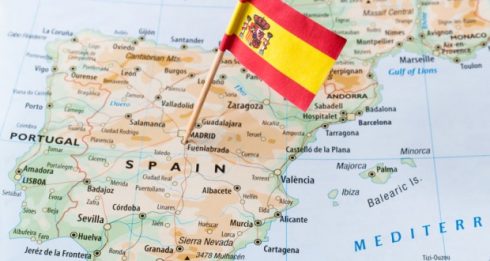Americans who are non-European nationals are at a disadvantage when obtaining a residence visa in Spain.
But there are many ways Americans can legally immigrate to the sunny Iberian Peninsula, some easier than others.
Generally, non-European Union residents cannot legally stay in Spain for more than 90 days in a 180-day period without a visa.
Fortunately, there are a variety of visa pathways available to Americans, each appealing to different demographics and situations.
- Pareja de Hecho
Perhaps the easiest and most common way to obtain long-term residency in Spain is to find a Spanish partner.
Through what is also called a “civil association” or “pareja estable” in some communities, foreigners can obtain residency rights through the pareja de hecho if they can prove that they live and share life with Spanish nationals. Can be done.
Once registered as a Pareja de Hecho, a U.S. citizen can become a so-called Tarkheta community, This will allow them to legally live and work in Spain for five years and allow them to travel freely throughout the European Union.
The process can be completed from within Spain with a standard 90-day tourist visa, allowing applicants to enter the country without a residence permit and obtain a visa locally.
However, applicants should note that each autonomous community in Spain has its own set of requirements.
In Madrid, for example, couples must prove they have lived together for at least 12 months.
However, in communities in Catalonia and Aragon, there is no minimum cohabitation requirement.
If the couple has children, proof of cohabitation is not required.
However, in all communities, applicants must be able to prove that they are legally single (i.e. unmarried) and over 18 years of age.
Additionally, one of the partners must be registered as a legal resident (called an empadronado in Spain) of the autonomous community to which you are applying.

- golden visa
The Golden Visa, officially known in Spain as the “Investor Visa”, so called because of its extensive privileges, is available to foreigners who want to buy real estate or make large investments in the Spanish economy. can.
This can mean many things.
Golden Visa applicants can invest 2 million euros in Spanish public bonds or 1 million euros in the Spanish stock market, Spanish venture capital funds or Spanish banks.
Purchasing real estate worth at least €500,000 is also an option, as are investments in business projects that create jobs and significantly stimulate the local economy, or that make what the Spanish government calls a “significant contribution to scientific and technological innovation.” This will make those eligible for the Golden Visa. Read web pages.
The investor’s spouse and dependent children can also obtain residency through the Golden Visa.
As with other types of visas, applicants must submit a number of documents as part of their application, including a visa application form, a copy of their passport, a photo, an apostille and translated criminal record certificate, and a certificate proving their criminal record. Documents must be submitted. Among other things, I took out private health insurance in Spain.
And perhaps most importantly, applicants must provide evidence of investment in the Spanish economy.
What this looks like depends on the type of investment.
Examples include a declaration from the Ministry of Economy in the case of investments in the stock market, or a recently issued certificate from the Land Registry proving ownership of real estate in the case of investments in real estate.
- digital nomad
The Digital Nomad Visa is an attractive option for remote workers seeking the freedom to roam and work under the Spanish sun, and for foreigners who are self-employed or employed by a company outside of Spain and work solely using a computer. Available.
To qualify for the Digital Nomad Visa, applicants must have a university degree or at least three years of work experience in a designated field and be able to demonstrate the financial means to support themselves in Spain. there is.
This is twice the monthly minimum wage in Spain, or about $2,300 per month.
For this visa, applicants have the option of applying from within Spain on a tourist visa or through their local Spanish consulate in the United States.
If applying from the United States, applicants will initially receive a one-year residence permit, which can be extended to three years upon arrival in Spain.
Similar to other visas, to obtain a digital nomad visa, applicants must provide an apostillation and translated criminal record proving they have no criminal record, private health insurance, a photo, a visa application, and employment. You must submit proof.
Additionally, if the contract is with a foreign company, that company must have been in existence for at least one year before the application is submitted and clearly state that the applicant’s position allows remote work. need to be proven.
If the applicant is a freelancer, the contract must indicate the ability to work remotely.
Please note that, unlike other visas, digital nomad applicants must apply for a Spanish Alien Identification Number (called NIE) before applying for a visa. This process requires unique documentation and an appointment.
According to the Spanish Consulate General’s website, NIEs are usually issued within two weeks, but delays can occur.
- study abroad visa
This option is popular among young people who are not yet tied to a specific career and who do not necessarily intend to live permanently in Spain.
Although each type of study visa includes different rules, regulations, and application processes, there are a variety of activities that can qualify for a study visa, and they all follow a similar application process.
Perhaps the easiest way to obtain a study visa is to apply for a Spanish university degree program known as a “general student visa”.
Applicants may qualify for a study visa if they study full-time (20 hours or more per week) at an accredited institution that issues a degree, diploma, or certificate.
This could be an undergraduate or master’s degree, a doctoral program, a middle school or high school exchange program, studying Spanish at a private language school, or an internship program.
There are various private language schools with visa programs throughout Spain that offer visas to students willing to pay to take language classes throughout the year.
The price of these programs varies, but it is not uncommon for them to cost more than $2,000 to $3,000 per year.
The ‘Internship Visa’ is available to people who have completed a university degree within the past two years and have undertaken an internship for professional development, or who are currently undertaking an internship as part of their studies.
For general student visas, in addition to the aforementioned documents required for all types of visas, applicants must provide proof of enrollment in a full-time program and a valid letter of acceptance. Details can be found on the consulate’s student visa webpage. .
For this type of study abroad visa, Spanish consulates recommend applying as early as possible, and applications are accepted from six months before the start of your study abroad program.
Another type of study visa is available through a program known as the North American Language and Cultural Assistant Program (NALCAP).
Through this language exchange program, sponsored by the Spanish Ministry of Education, native English speakers are assigned to work as conversation assistants in Spanish elementary or secondary schools, working with Spanish teachers to teach classes in English.
NALCAP participants serve as cultural ambassadors between the United States and Spain and are required to speak English only to students.
The program typically runs from October to May, with an application cycle in the spring and is implemented in towns of all autonomous communities in Spain.
NALCAP participants should expect to work 14-16 hours per week as a language assistant.
Although NALCAP participants can specify their preferences on their application, please note that they may not have the final say on which city they end up staying in.
Finally, there is a study abroad visa program for people between the ages of 17 and 30 who want to work as au pairs.
Au pairs live in the homes of Spanish families and typically look after children in exchange for room and board.
For this type of visa, the agreement between the applicant and the host family must not be a labor agreement. This means that the pair will not receive a salary.
Applications must include a signed notarized letter from the host family containing contract details.
Additionally, applicants must register at a Spanish language school in Spain.
Most types of study visas require proof of financial means, as applicants are expected to study full-time, but this can be done in a variety of ways.
In some cases, proof that housing and expenses will be covered by the university or educational institution, or a notarized letter from a parent or guardian stating that the applicant will be responsible for all of the applicant’s living expenses may be accepted. there is.
Each type of visa also has different requirements, depending on the desired length of stay.
For example, visa applications for more than 180 days may require additional documentation, such as certifications and criminal background checks.
read more

